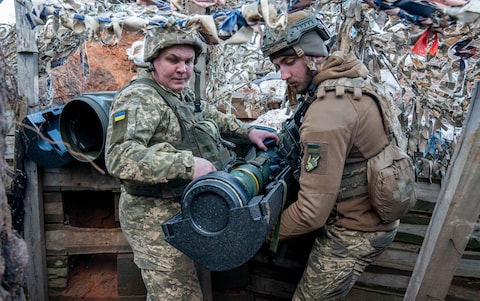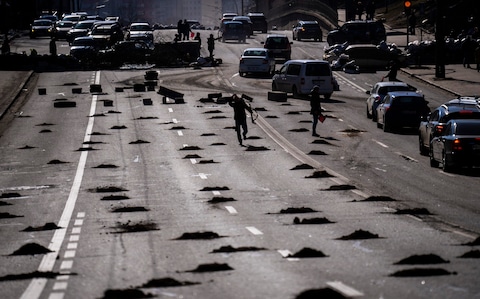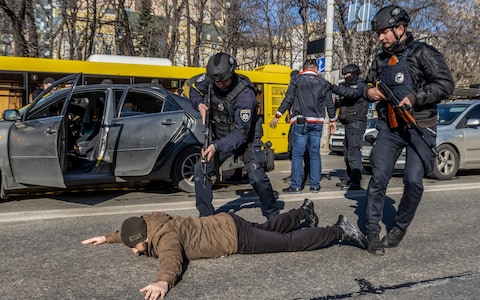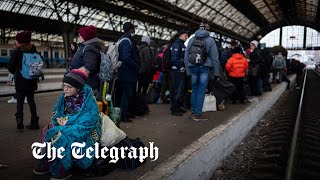Invaders’ push towards the capital halted after column is hit by Ukrainian artillery and drone strikes
https://i.imgur.com/jGfFWPX.jpeg
The satellite images showed a vast Russian convoy bogged down on the road to Kyiv.
Military experts said the 17-mile column, which more than doubled in size overnight on Monday, was a sitting duck for Ukrainian artillery and drone strikes. About 20 miles from where it was last spotted, the Russian advance appeared to have hit a wall.
In Bucha, 15 miles north-west of Kyiv, images posted online showed the bloody aftermath of one of the most brutal ambushes and firefights of the five-day-old war.
In Kyiv itself, Russian special forces troops were halted by guards at one of the city’s most famous religious landmarks. A photograph showed what appeared to be a Russian corpse lying close to St Michael’s Golden-Domed Monastery, while the local orthodox archbishop issued a statement claiming the “saboteurs” had been “neutralised”.
As talks were taking place just across the border in Belarus, Russian troops faced being massacred on the roads into the capital. If Russians were being killed by church guards, the resistance could clearly be no pushover.
On Monday, there were reports of loud explosions on the edge of the Kyiv as the Russian army attempted to make its move on the capital.
However, the evidence of the fight it faced was highlighted by mobile phone footage of the mangled wreckage of tanks and armoured personnel carriers in Bucha’s residential quarter.
About 15 vehicles had been destroyed along with much of a half-mile section of the street. Trees and houses that lined the road had disappeared in the explosions.
“Look what they did to my home, but we gave as good as we got and now all that’s left of the invader is spare parts,” said one resident, giving a running commentary on mobile phone footage in reference to the remnants of tanks and other Russian kit. He could have been talking about body parts, too. Other videos showed the corpses of Russian troops.
Anatolii Fedoruk, the mayor of Bucha, celebrated the defeat even as he surveyed the destruction: “The armed forces of Ukraine stopped the enemy’s column… These are the results of their invasion and the work of our armed forces. Unfortunately, the private sector [houses] also received damage, but we will rebuild. Wishing health to our armed forces who have worked very well. Everything will be Ukraine.”
British defence intelligence issued its own update on Monday, suggesting Russian forces had become immobilised. “The bulk of Putin’s ground forces remain more than 30km to the north of Kyiv, their advance having been slowed by Ukrainian forces defending Hostomel airfield, a key Russian objective for day one of the conflict,” it said.
In its assessment, the MoD added: “Logistical failures and staunch Ukrainian resistance continues to frustrate the Russian advance.”
Further down the road from Bucha, Ukrainian forces used Western-supplied anti-tank missiles to destroy another Russian convoy on a bridge that serves a main route into Kyiv. The Russian column had been obliterated and corpses lay at the side of the road. Ukrainian officials briefed CNN that they were “enthused by the victory on the bridge”.
The north-west route into Kyiv from the Belarus border via the wastelands of the radioactive Chernobyl nuclear power plant had been key to Vladimir Putin’s hopes for a speedy end to a conflict that threatens to drag on for weeks, maybe longer.
Ukraine is being rearmed by the West, while the Russian advance on the capital appears, at least for now, to have stalled.

Ukrainian soldiers handle a British-manufactured NLAW anti-tank weapon on the frontlines CREDIT: Alex Lourie
Russia’s military leaders had planned a lightning attack by seizing control of Hostomel airport and the spot where the convoy was wiped out. Special forces had claimed control of the airfield in the first hours of fighting, sending in attack helicopters to offer air support for the ground forces.
The plan had been to bolster numbers by flying in airborne troops on huge Ilyushin IL-76 transporters before making a direct attack on Kyiv’s seat of power, capturing President Volodymyr Zelensky, overthrowing his government and putting in its place a puppet regime.
But the battle for Hostomel was lost by Russia and Ukraine retains control. At least one IL-76 plane, thought to be carrying about 100 Russian special forces troops, was shot down before it could land. Satellite images that emerged on Monday showed damage to the airfield with what appeared to be large craters in the runway that will prevent Russia from using it, even if it managed to wrestle it back from Ukraine in the coming, critical few days.
With Hostomel off limits, Russian convoys remain easy targets on the road to Kyiv. Along the route, Ukraine troops have launched ambushes and civilians have put in place blockades to slow the advance.
One video posted on Monday showed three middle-aged Ukrainian civilians building a makeshift military barricade, piling hundreds of rubber tyres and sandbags as well as metal barricades 10ft high while about a quarter of a mile away a Russian convoy has halted on a bridge. Spikes were scattered to frustrate troop-carrying trucks and fuel tankers. The makeshift barricade was enough to make the Russian commander order a halt.
The “neutralisation” of Russian “saboteurs” inside Kyiv shows the difficulties facing the Kremlin even if its forces infiltrate the city. Archbishop Evstratiy Zorya, of the Orthodox Church, issued a statement thanking the guards “for their vigilance” and accused Moscow of targeting the head of the church, Primate Epiphanius Dumenko.
“It is well known that in his speech before the start of the war, Putin had complained about the existence of a church independent of Russia in Ukraine. We also know from international partners that the occupier had compiled lists of targets of their terror, including leaders of Ukrainian society and the state.

Vehicle-blocking measures have been put in place on the road to Kyiv CREDIT: Emilio Morenatti
“These public reports, as well as information that cannot be made public now gave grounds to objectively believe that the Primate of the Orthodox Church of Ukraine is among the targets of Russian terror. Given this, special security measures were taken to prevent irreparable consequences for the local church and Ukraine at this time of struggle for freedom.”
Ukraine authorities said there remained a “systematic struggle against a small number of sabotage-reconnaissance groups numbering three to 15 people with weapons”. They wore the uniform of the Ukrainian army but beneath they sported “bulletproof vests of the Russian Federation”.
In briefings by the Ukrainian government, officials said the military had “deployed a dense and multilevel system of defence of the capital”, including using tanks and artillery. The Ukraine air force continued to operate along with drones that the Russian bombardment had failed to knock out, depriving Moscow’s forces of air superiority.
The stalled convoy consists of a number of battalion tactical groups – transporting about several thousand soldiers as well as hardware – and was first picked up on satellite by a US tech firm. When it was spotted on Sunday, it was about three-and-a half miles long, but now with gaps, it stretched to at least 17 miles.

City authorities issued a notice to drivers using Kyiv-registered phone numbers on Monday not to use bus lanes on the right hand of the road CREDIT: Anadolu Agency
The line of vehicles is so long the satellite could not capture it in one image. In some places, the carriers and trucks were two to three rows deep. These are the troops Russia’s military command will hope can join the fight for Kyiv, possibly encircling the city and laying siege to it.
Philip Ingram, a retired colonel in military intelligence, believes it is highly vulnerable to attack. Ukraine’s ability to pick off at least elements of the convoy may likely decide the outcome of Russia’s war with Ukraine.
“It is a military disaster to have a convoy that length stuck on the road in the middle of a conflict zone where you don’t have air superiority. It is a sitting duck,” said Mr Ingram. “The presence of this convoy has been so well broadcast across open-sourced sites that Ukrainians will know where it is and will give it as much action as possible to halt it. It is a free hit for the Ukrainians. The Russians should not have allowed a convoy that big to develop.” In Kyiv last night, the civilian population remained prepared for battle.
Standing over a trench, a young Ukrainian filmmaker armed with a rifle and kept guard while his friends prepared Molotov cocktails. Three volunteer fighters, dressed in olive fatigues, worked up a sweat a few steps away, positioning a piece of artillery on to a patch of grass separating two lanes of a big city road.
Electronic billboards around them flashed messages warning invading Russian soldiers that “instead of flowers, you will be greeted with bullets”.
Andriy Ivanyuk, a filmmaker, was defiant. “The Russians know very well that our land is burning under their feet,” Mr Ivanyuk told the AFP news agency.
After a 36-hour curfew, Ukraine’s residents came out to make their preparations for the defence of the city. Viktor Rudnichenko, a bank employee, said: “We will greet them with Molotov cocktails and bullets to the head, that’s how we will greet them. The only flowers they might get from us will be for their grave.”

Tens of thousands of Kyiv residents, mainly women and children, had fled the capital but those that remained out of the three million population queued on Monday for bread, water and other supplies. Checkpoints were fortified with furniture, rubber tyres and anything else that could be used to form a barrier. Passers-by were told not to walk on the grass for fear of stepping on landmines planted, it was claimed, in the night by Russian infiltrators.
“We heard the Russians are hiding mines in the grass,” said Oleksiy Vasylenko, 27, part of the volunteer army.
Amid heightened tensions, the city issued a notice to drivers using Kyiv-registered phone numbers on Monday not to use bus lanes on the right hand of the road.
“If you drive in the bus lane, you will be a saboteur and dealt with accordingly,” the message from the city warned.
The checkpoints remain manned by what reporters on the ground described as “nervous and occasionally angry” men who demand identity papers while pointing their Kalashnikovs at cars.
The pass code for easier passage, said AFP, is “Slava Ukraini” (Glory to Ukraine), the national salute despised deeply in the Kremlin and traditionally followed with the response: “Geroyam Slava” (Glory to the Heroes).
“There are enough people here to resist,” said Yuriy Gibalyuk, 50, a vet. “We will resist, the whole of Ukraine will resist, whether it is Kyiv, Lviv or Donetsk.”
The next 48 hours will be critical in the fight for Kyiv. The loss of life on both sides threatens to be catastrophic.